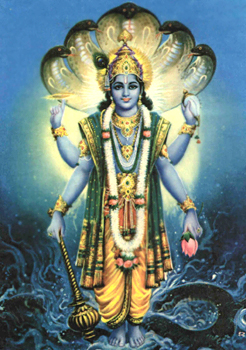 Content of Dhrupad was largely devotional in nature when this musical style first emerged. Gradually, it went on to acquire other themes in its composition. When the Dhrupads first emerged, the Bhakti movement of Vallabha Sampradaya was in its full force. The central theme of the Sampradaya was the worship of Lord Vishnu in all his Avataars. Thus these early Dhrupads were chiefly in praise of Lord Vishnu and his various incarnations. These were called Vishnupadas. The Bhagavata Purana made such a deep impact on the religious culture of India that it is not at all surprising that the Dhrupads frequently took the narratives of the life of Lord Krishna and his hymns as their subject-matter. It can thus be visualized that the Bhakti movement formed the background of the scene at the time of the birth of Dhrupad. This explains why Dhrupads were quickly taken up as a vehicle for the propagation of the Bhakti cult. It was usual for Vaishnava mendicants to roam around with their Vind and sing Dhrupads in the form of devotional songs. This was the genesis of Haveli Dhrupad (the temple Dhrupad).
Content of Dhrupad was largely devotional in nature when this musical style first emerged. Gradually, it went on to acquire other themes in its composition. When the Dhrupads first emerged, the Bhakti movement of Vallabha Sampradaya was in its full force. The central theme of the Sampradaya was the worship of Lord Vishnu in all his Avataars. Thus these early Dhrupads were chiefly in praise of Lord Vishnu and his various incarnations. These were called Vishnupadas. The Bhagavata Purana made such a deep impact on the religious culture of India that it is not at all surprising that the Dhrupads frequently took the narratives of the life of Lord Krishna and his hymns as their subject-matter. It can thus be visualized that the Bhakti movement formed the background of the scene at the time of the birth of Dhrupad. This explains why Dhrupads were quickly taken up as a vehicle for the propagation of the Bhakti cult. It was usual for Vaishnava mendicants to roam around with their Vind and sing Dhrupads in the form of devotional songs. This was the genesis of Haveli Dhrupad (the temple Dhrupad).
Dhrupad caught the attention of the Hindu and Muslim rulers of the time somewhat later and the Dhrupad began to find a place in the courts or Darbars. The courts or Darbars provided a healthy climate for the growth and development of music, art and culture, and thus Dhrupad began to nourish under this new patronage. This accounts for the development of another branch of Dhrupad which is called Darbari Dhrupad or court Dhrupad. Since the Darbari Dhrupad developed in the courts of kings and feudal lords, there was now a change in the content of the Dhrupad compositions. Now Dhrupads began to be written in praise of chivalrous deeds, real or imaginary, of various kings and patrons and in descriptions of Nayakas and Nayakas.
Thus from its earlier devotional nature, a very wide range of subjects formed the content of Dhrupads. The entire range of content and themes of Dhrupad songs includes hymns in praise of other gods and goddesses, the narrations of the chivalrous acts of kings and great men and of patrons of music, erotic descriptions of the beauty of Nayakas and Nayakas, expositions of such subjects as Yoga, Nada Brahma philosophy, musicology, metaphysical subjects etc.




